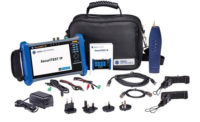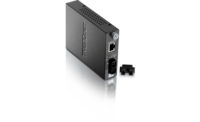When it comes to network connectivity devices, reliability is an absolute must. Whether it’s the Wi-Fi service, network switching or media converters, any network hardware must work perfectly through thick and thin, 24/7/365.
My favorite manufacturer of network switches, routers and media converters is without a doubt TRENDnet. I have used TRENDnet products in my home network for several years with nary a hiccup or failure.
On my daughter’s upstairs desk and connected to six IP cameras/video encoders is the TRENDnet TPE-S44 network switch/PoE power source. This little gem provides 802.3af standard PoE on four of its eight ports, and has 30 watts of available PoE. Along with a rugged steel cabinet, 1.6 Gbps of switching capacity, this little titan has been powering and connecting IP cameras to my LAN for more than four years.
Connecting the upstairs desk to my downstairs office/network equipment closet is a set of TRENDnet Powerline 1200 AV2 (part #TPL-421E2K) Ethernet over AC power line plug-in modules. These devices provide LAN Ethernet connectivity by using the existing AC power outlets in a home or business.
The downstairs AV2 Ethernet/AC media converter is connected to a TRENDnet TEW-812DRU Wi-Fi router/switch. I replaced my old black and purple Linksys 80211g router around two years ago with this 802.11ac supercharged Wi-Fi router, and immediately the bandwidth to our Wi-Fi laptops and other devices was doubled. This marvelous device provides two separate programmable Wi-Fi bands using the 802.11ac (1300 Mbps) and 802.11n (450 Mbps). A “guest” Wi-Fi network can be quickly configured so visitors who want to use the Wi-Fi can get on the router but can only communicate with the Internet and cannot access any of the other devices/servers on the LAN.
All wired switch ports are 10/100/1000 and provide Gigabit Ethernet connectivity to high-bandwidth ISP adapters and local devices. At less than $100, this TRENDnet Wi-Fi router is a drop-in replacement for obsolete 802.11b/g/n routers and will double or triple your clients’ Wi-Fi bandwidth.
The beauty of TRENDnet is not only do they make highly functional yet inexpensive network hardware, but they also have many products that can be of great use to system integrators on large installations.
An example is the 18-Port Gigabit “NVR” PoE+ TRENDnet TPE-3018L, one of which was sent to me for testing.
At this point I want to explain some of the issues the author faces when performing reviews of products from our vendors. I have often been stumped when trying to get a new device to work and end up on the vendor’s tech support line trying to figure out what I am doing or not doing that is making the device non-functional. I am not the sharpest knife in the drawer but have been successfully programming and connecting IP devices to LANs and the Internet for more than 10 years. At this point I figure I should be able to get just about any device up and running.
I will admit that this TRENDnet PoE+ switch has sat in its shipping container for three months without being touched. Between running the road doing speeches, training classes and dealing with life in general, I put off cracking the box open on this switch because I feared there would be lots of programming options that I would need to explore and possibly manipulate to get this switch to work properly.
But today was the day. I pulled the TPE-3018L out of the box and reached for the “Quick Start” guide with trepidation…how long was it going to take to get this device performing? To my total surprise the “Quick Start” manual is literally a single diagram, showing the connection of PoE cameras, AC power to the switch, and uplink ports for connectivity to NVR/VMS servers and other network switches. A quick review of the documentation showed no indication of a default IP address for the switch. Then I had the revelation: this is a pre-programmed network switch specifically designed for IP camera installations that requires no management settings to make it dance. I plugged an Axis PoE camera into the switch along with my laptop, and it was up and running as soon as I applied AC power to the switch.
What makes this switch so useful is that it was designed to provide maximum PoE power and Gigabit connectivity for up to 16 IP cameras/encoders, along with two shared uplink ports that are both RJ-45 and SFP module compatible. More than 16 cameras on a particular installation? Just start stacking the TPE-3018Ls and using the shared Gigabit ports to connect them. With 220 watts of available aggregate PoE power this switch has buckets of wattage to power PoE devices, and the 36 Gbps switching capacity means that high-resolution IP cameras can easily be accommodated.
One cool feature is the four-digit, seven segment LED display which can be scrolled to present the aggregate PoE available as well at the total PoE being drawn by connected devices. The switch is rack-mountable, and also provides LED indications of connected devices.
The design of the TPE-3018L demonstrates the commitment that TRENDnet has to our industry. Using this switch greatly simplifies the connections of up to 16 PoE cameras, and the shared Gigabit uplinks will send all of the video to the NVR without a fuss.
As I have learned through first-hand experience over the past three years, you cannot go wrong using TRENDnet network switches, routers or media adapters. This is the stuff that works. Visit www.TRENDnet.com for more information.






